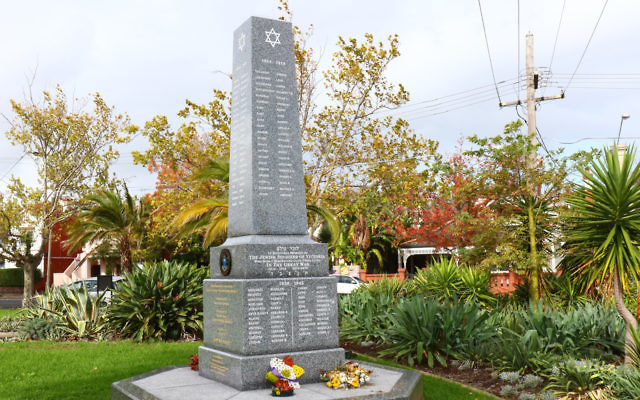A monumental error
A CLARIFICATION will be inscribed on a Jewish community plaque honouring fallen Jewish Diggers after a glaring error in the inscription was pointed out.
A CLARIFICATION will be inscribed on a Jewish community plaque honouring fallen Jewish Diggers after a glaring error in the inscription was pointed out.
The memorial, erected in a Ripponlea park last year to mark the centenary of the Anzac landings at Gallipoli, refers to 1938 as the year World War II broke out, when in fact it was 1939.
The incorrect years for World War II are repeated in numerous inscriptions on the memorial, including the honour roll.
The error has drawn the ire of the Victorian branch of the Australian Jewish Historical Society (AJHS) and of Melbourne Ports MP Michael Danby, who helped fund the project through the Department of Veterans Affairs.
Built in the style of “The Obelisk”, a memorial in the Jewish section of the Melbourne General Cemetery, the project received funds from the Pratt Foundation, the Department of Veterans Affairs (through Melbourne Ports), philanthropists Marc and Eva Besen and the Gandel Group.
Judy Landau, outgoing president of the Victorian Association of Jewish Ex & Servicemen and Women (VAJEX), the organisation that coordinated the project, told The AJN that 1938 had been chosen as the start of World War II because she and members of her committee felt it would honour the victims of Kristallnacht, the Nazi pogrom in Germany and Austria that occurred in November of that year.
An announcement on the VAJEX website about the memorial, which was officially dedicated on November 15 last year, stated: “The year 1938 will be used instead of 1939 for the beginning of WWII as it is accepted that Kristallnacht (9-10 November 1938 ~ 15-16 Cheshvan 5699) marked the beginning of the Holocaust. Therefore, for Jews, it could be said that WWII began for us in 1938.”
Landau told The AJN: “Because it’s a Jewish monument, some of my advisers wanted to have a silent tribute to those who were lost with Kristallnacht.”
She said that at the VAJEX AGM, a member of the organisation had suggested to her a plaque “saying why we used that date”, should be added to the memorial.
But Landau conceded “there’s no question” World War II actually began on September 1, 1939 and the clarifying inscription would be added after delays brought on by personal family matters.
AJHS president Howard Freeman said while the memorial is “an extremely worthy endeavour”, he was deeply concerned “the president of VAJEX has taken it upon herself to distort history”.
“While Kristallnacht was an appalling event and should obviously be commemorated, it has never been designated as the start of the Second World War. This began with the Nazi invasion of Poland and the subsequent declarations of war by Britain and the Commonwealth, including Australia, in September 1939,” Freeman noted.
He said the factual error in the inscription “reflects on the whole Jewish community, making the Jewish community appear ignorant of the most important events of our history”.
Contacted by The AJN, Danby said he would not have sought funding for the project if he had known that historical dates would be tampered with. “If I had any idea of this behaviour from VAJEX in inscribing the obelisk, I would not have recommended it receive a significant Commonwealth Anzac Centenary grant.”
PETER KOHN


comments